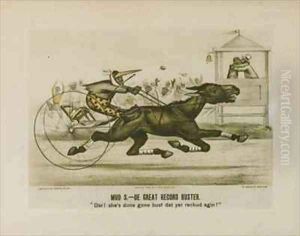Currier, N. & Ives, J.M. Paintings
Nathaniel Currier (1813–1888) and James Merritt Ives (1824–1895) were American printmakers who headed the company Currier & Ives, which became famous for its lithographic prints of American scenes. Nathaniel Currier was born in Roxbury, Massachusetts, and showed an early interest in lithography, setting up his own shop in 1835. James Merritt Ives, born in New York City, initially worked as a bookkeeper before joining Currier's firm in 1852.
Currier earned a reputation for crafting lithographs of newsworthy and historical events, which were distributed as inexpensive and popular prints. The collaboration between Currier and Ives began in 1857, when Ives, who had proven to be an adept manager and had a keen eye for the public's taste, was made a full partner, and the firm's name changed to Currier & Ives.
The firm produced over 7,500 images during its existence, which depicted a wide variety of subjects, including domestic scenes, landscapes, historical events, and political caricatures. These prints were a form of mass media in the 19th century and served to document and shape American culture and identity. The lithographs were hand-colored after printing, which made them both affordable and appealing to a broad audience.
Currier & Ives's work was characterized by its clean lines, attention to detail, and wholesome portrayal of American life. The firm enjoyed great success and was responsible for some of the most iconic images of the era, which remain popular in Americana.
After the deaths of both founders, Currier in 1888 and Ives in 1895, the company continued operating under different management until 1907. Today, original Currier & Ives lithographs are highly sought after by collectors, and the images are iconic representations of 19th-century America. The legacy of Currier & Ives is evident in their lasting impact on American visual culture.










